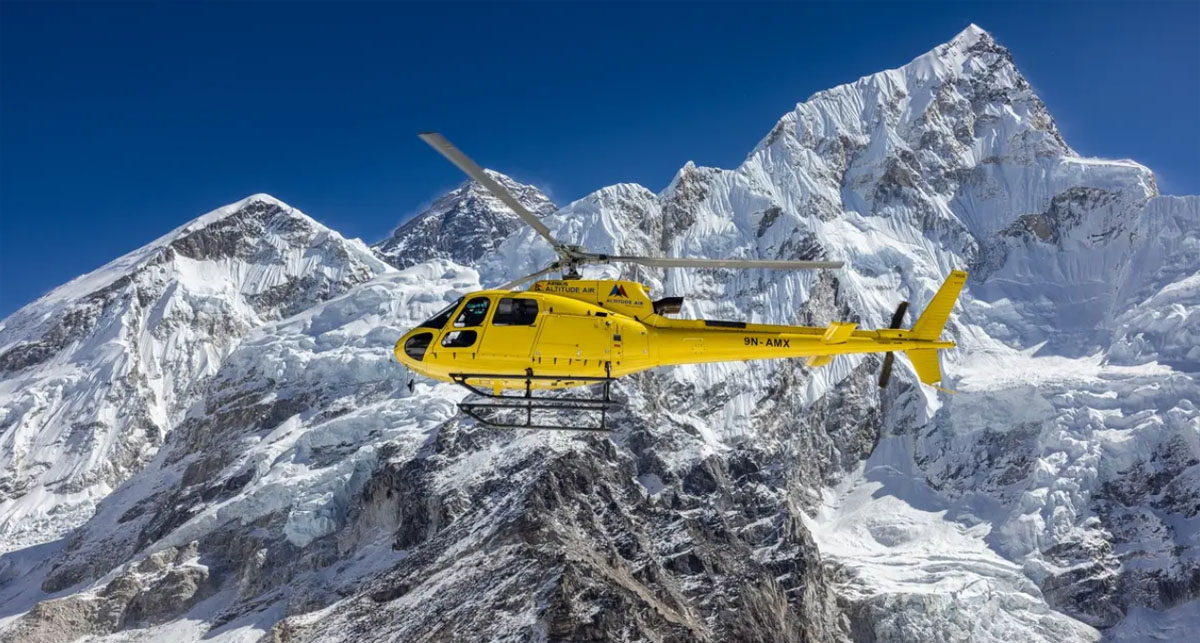

KATHMANDU: High above Nepal’s rugged Himalayas, helicopters hum tirelessly—carrying climbers, ferrying pilgrims, conducting rescues, and linking remote communities where roads often end before the journey begins.
This vital industry is not only a pillar of Nepal’s tourism and emergency response systems but a lifeline for millions living in mountainous regions.
Today, twelve helicopter companies operate across the country, managing a fleet of more than 40 aircraft. These operators transport between 75,000 and 100,000 passengers annually, encompassing international tourists, local travelers, medical evacuations, cargo runs, and government missions.
But the sector now faces a pivotal moment: expanding demand meets growing regulatory scrutiny, financial challenges, and environmental concerns.
Nepal’s Leading Helicopter Operators: Who’s Flying the Skies?
Nepal’s helicopter industry consists of a mix of established and emerging operators, each carving out specialized roles in a competitive market. The major companies currently operating include:
These companies collectively carry 75,000 to 100,000 passengers annually, balancing tourism, rescue, cargo, and VIP flights.
Their fleets consist mainly of the Airbus H125 (AS350 B3e), Bell 407 GXP, Bell 206L LongRanger, and Robinson R66, among others.
New Entrants in Helicopter Business
Types of Helicopter Flights: From Everest Sightseeing to Emergency Rescue
Nepal’s helicopter operations can be grouped into four broad categories:
Passenger Volumes and Seasonal Peaks
Annually, Nepal’s helicopters transport 75,000 to 100,000 passengers:
Passenger numbers peak in March–May and September–November, corresponding to the spring and autumn trekking seasons when weather conditions are optimal.
Most helicopter operations originate from Kathmandu’s Tribhuvan International Airport heliport and Pokhara International Airport, with regional hubs in Nepalgunj, Surkhet, and Biratnagar facilitating quicker responses and reducing ferry times.
Flight Identification and Air Traffic Management
Unlike fixed-wing commercial airlines, Nepal’s helicopter flights generally lack standardized flight numbers. Instead, the Civil Aviation Authority of Nepal (CAAN) issues Temporary Flight Clearances (TFCs) for each flight, which serve as unique identifiers.
For instance, Air Dynasty’s Everest Base Camp flights may be logged as “ADH-EBC-001” through “ADH-EBC-020” during peak seasons. Simrik Air and Manang Air similarly designate their missions with flight codes to streamline air traffic control and emergency response coordination.
Challenges: Safety, Regulation, and Financial Sustainability
Safety Risks and Accident History
Nepal’s challenging geography and volatile weather contribute to helicopter risks. Since 2018, there have been at least six fatal crashes, including:
Causes often involve sudden weather shifts, terrain awareness difficulties, and occasional pilot pressure to fly in marginal conditions. These incidents have prompted CAAN to mandate installation of Terrain Awareness and Warning Systems (TAWS) and tighten pilot visibility minimums.
Regulatory Oversight and Industry Transparency
CAAN regulates safety and airworthiness but faces criticism for inconsistent enforcement and lack of an independent accident investigation board. Many investigations are internally handled with limited transparency, affecting public trust.
Pilots report operational pressures during high-demand seasons, and allegations of insurance fraud and staged rescue flights have marred the sector’s reputation.
Financial and Operational Realities
Helicopter operations are costly, with significant fixed expenses:
Tourism flights are the most lucrative, with Everest sightseeing costing up to $5,000 per charter, and group flights to EBC priced at $1,200–$1,800 per passenger. Medevac and rescue flights command premium pricing, often negotiated on a case-by-case basis.
Smaller operators like Prabhu Helicopter and Kailash Helicopter struggle with limited fleets and underutilized routes, threatening financial viability.
Environmental and Community Impacts
Noise pollution and emissions from frequent helicopter flights affect fragile ecosystems and local communities, particularly in the Everest region.
In 2025, the Khumbu Rural Municipality in Solukhumbu banned non-rescue helicopter flights over Everest to protect the environment.
Operators like Simrik Air, Air Dynasty, and Altitude Air participate in carbon offset programs and explore fuel-efficient aircraft.
Community engagement initiatives, including training local rescue volunteers and improving landing zones, are increasingly common.
Government Policies and Industry Consolidation
CAAN’s new policy requires operators to have at least NPR 500 million in paid-up capital before obtaining an Airline Operator Certificate. This aims to consolidate the market by eliminating undercapitalized firms and encouraging efficiency.
New entrants like Sumedha Air and Sagarmatha Air will intensify competition, driving modernization through investments in GPS navigation, regional maintenance hubs, and advanced pilot training.
Looking Ahead: Balancing Growth and Safety
Nepal’s helicopter industry is at a crossroads. With growing demand driven by tourism, disaster response, and infrastructure needs, the sector must balance rapid growth with enhanced safety standards, better regulation, and environmental stewardship.
For the 75,000 to 100,000 passengers who take to the skies annually, the promise of swift connection must be matched by a commitment to sustainability and risk reduction.
As Nepal’s roads remain vulnerable to nature’s whims, its helicopters remain indispensable—a lifeline that connects the nation, no matter the terrain.